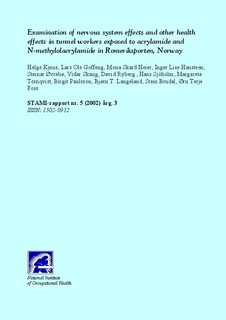| dc.description.abstract | OBJECTIVES: This study examined nervous system effects and other health effects in tunnel workers exposed to acrylamide and N-methylolacrylamide during tunnel work. METHODS: Symptoms and nerve conduction properties were recorded in 25 tunnel workers exposed to acrylamide and N-methylolacrylamide during grouting operations, four and 16 months after the cessation of exposure. Visual evoked response (VEP) and electroretinography (ERG) were performed 16 months post exposure. Hemoglobin adducts of acrylamide were measured and qualitative exposure indices were developed. Fifty unexposed tunnel workers served as referents. Chromosome aberrations and the distribution of Glutathion S transferase (GST) genotypes (M and T) were also examined in the 25 exposed workers, and were compared to 25 age and smoking matched referents. RESULTS: The exposed workers reported an increased prevalence of symptoms during grouting work compared to the examination after 16 months. A statistically significant reduction in mean sensory nerve conduction velocity (NCV) in the ulnar nerve was observed 4 months post exposure when compared to the reference group (52.3 vs. 58.9 m/s, p=0.001), and mean ulnar distal delay was prolonged (3.1 vs 2.5ms, p=0.001). Both measures were significantly improved when measured one year later. By correlating outcome measurements with the qualitative exposure indices of the individual workers, exposure-related improvements from four to 16 months post exposure were observed both in the median nerve (motor and sensory NCV and F-response) and the ulnar nerve (sensory NCV, F-response). A significant reversible reduction in the mean sensory amplitude in the median nerve was also observed, while sensory amplitudes in the sural nerve were significantly reduced after 16 months. The amplitudes in the electroretinography on photoptic (30 Hz) stimulation were significantly lower in the exposed subjects compared to the referents. There were no clear differences in the neurophysiological outcome parameters related to GST genotypes M and T. Chromosome examinations showed no significant differences between the 25 exposed subjects and 25 of the referents for chromosome aberrations, chromatid breaks, chromosome breaks and chromosome gaps. A significant increase in chromatid gaps was observed in the exposed subjects, but no exposureresponse relationship could be found. Subjects with GSTM1-/GSTT1 genotype had slightly higher frequencies of all effect parameters compared to referents with the same genotype. CONCLUSION: The results indicate slight effects on the peripheral nervous system in tunnel workers related to exposure to N-methylolacrylamide and acrylamide during grouting operations. Apart from a 3 possible delayed axonal effect on sensory fibres in the sural nerve, the effects seemed largely to have been reversible, with normalisation 16 months post exposure. A possible slight change in the ERG suggests subclinical effects on photoreceptors (cones) in the central part of the retina. The pattern of the chromosome results may indicate a possible slight genotoxic effect. | |
